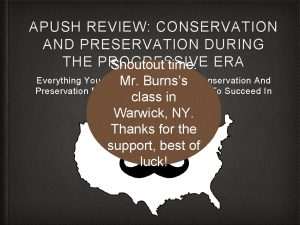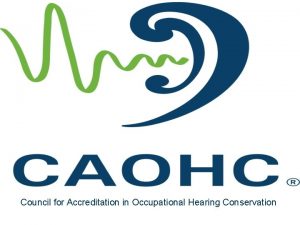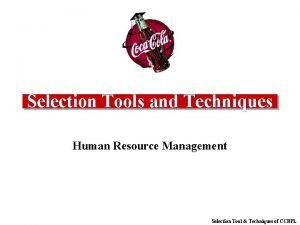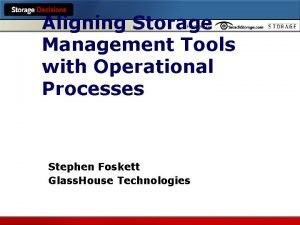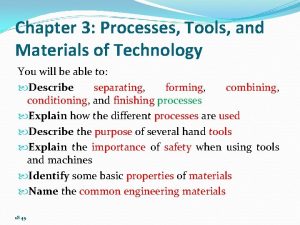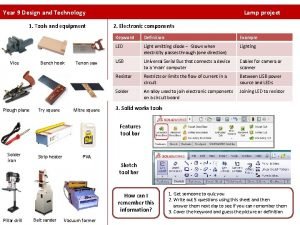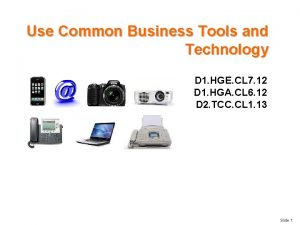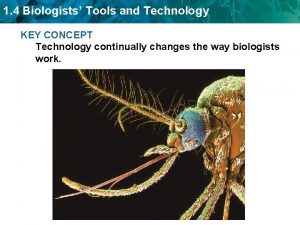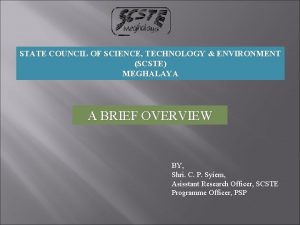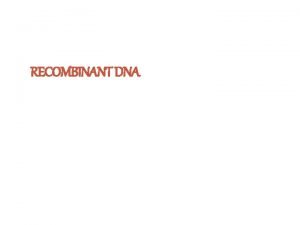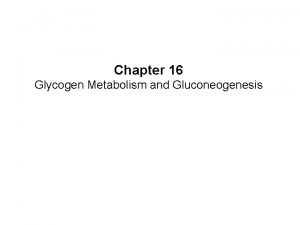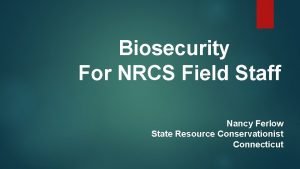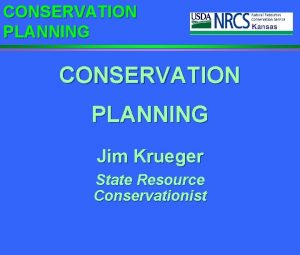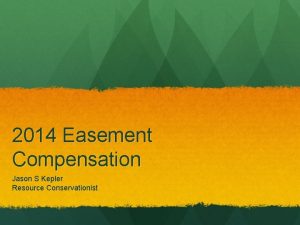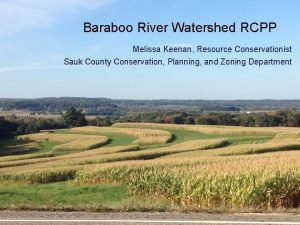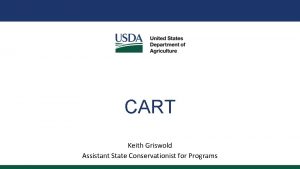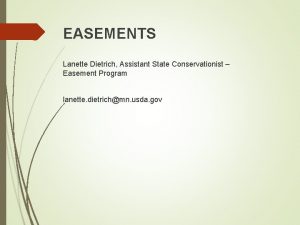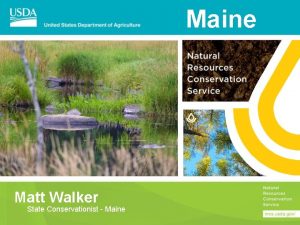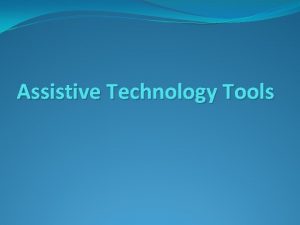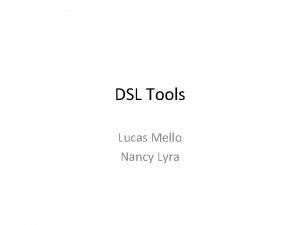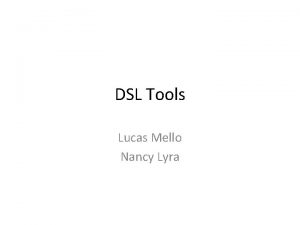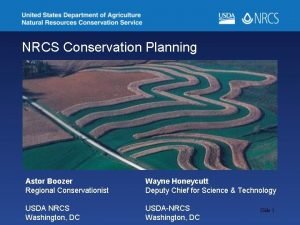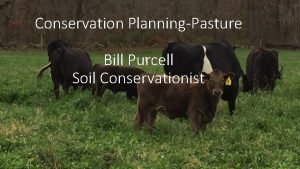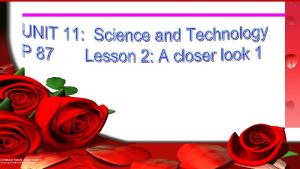TECHNOLOGY AND TOOLS Nancy Ferlow State Resource Conservationist





















- Slides: 21

TECHNOLOGY AND TOOLS Nancy Ferlow State Resource Conservationist Tolland, Connecticut July 2016 1

TECHNOLOGY AND TOOLS • • • RUSLE 2 Win. PST WEPS AWM/MMP Energy Grazing Engineering GPS/GIS CONSERVATION DESKTOP STREAMLING INITIATIVE (CDSI) & TOOLKIT 9 2

Assessment Tools – RUSLE 2 • One of our most basic tools for a planner • Used for Sheet and Rill erosion prediction • RUSLE 2 estimates sediment yield and sediment characteristics from overland slopes, low grade terrace type channels, and small sediment basins. • RUSLE 2 does not estimate ephemeral gully erosion. While ephemeral gully erosion within field sized areas is a critical element in conservation planning, the benefits of controlling ephemeral gully erosion are not explicitly considered in RUSLE 2.

Assessment Tools – RUSLE 2 • RUSLE 2 estimates the erosion, deposition, and sediment transport associated with overland flow. • RUSLE 2 is designed to be land use independent. • RUSLE 2 works better on some land uses than on other land uses because of the availability of data to derive parameter values.

Assessment Tools – Win. PST • WIN-PST is an environmental risk screening tool for pesticides. NRCS field office conservationists, extension agents, crop consultants, pesticide dealers and producers can use it to evaluate the potential of pesticides to move with water and eroded soil/organic matter and affect non-targeted organisms. • WIN-PST goes beyond previous NRCS screening tools in considering the impact of water table depth, rainfall probability, pesticide application area, application method and rate class (Standard, Low, Ultralow). • WIN-PST users can specify pesticides by product name or active ingredient. Long-term human and fish toxicity data and ratings are also included in WIN-PST. These toxicity ratings can be combined with the off-site movement potential ratings to provide an overall rating of the potential risks from pesticide movement below the root zone and past the edge of the field.

Assessment Tools – WEPS • Wind Erosion Prediction System • Not commonly used in the northeast • May be used in CT River valley where large tracts of land are left uncovered (agriculture or construction)

Planning Tools – AWM • Animal Waste Management • Used for planning and design of manure storage and treatment facilities • AWM has traditionally been used for designing waste storage structures such as storage ponds, tanks and anaerobic lagoons for liquids; and covered and uncovered dry stacks with or without walls for solids.

Planning Tools – MMP • Manure Management Planner (MMP) was developed at Purdue University to create manure management plans for crop and animal feeding operations. It uses information about the operation's fields, crops, storage, animals, and application equipment. MMP helps the user allocate manure (where, when and how much) on a monthly basis for the length of the plan (1 -10 years). This allocation process helps determine if the current operation has sufficient crop acreage, seasonal land availability, manure storage capacity, and application equipment to manage the manure produced in an environmentally responsible manner. MMP is also useful for identifying changes that may be needed for a non-sustainable operation to become sustainable, and determine what changes may be needed to keep an operation sustainable if the operation expands.

Planning Tools – Energy • “ 3 click” tools developed to increase energy awareness in agriculture and to help farmers and ranchers identify where they can reduce their energy costs. • Tools include Animal Housing, Irrigation, Nitrogen and Tillage

Planning Tools – Grazing • Numerous grazing templates and tools available • See your state grazing specialist for the one for your state.

Engineering Tools • • EFH 2 TR-55 TR– 20 EFT (Engineering Field Tools)

Geospatial Tools • ARC-GIS • GPS • Toolkit 9 and Conservation Delivery Streamlining Initiative (CDSI)

GPS STANDARDS AND USES Title 170, Part 581 – National Geospatial Manual Subpart C – Use of GPS Data in Mobile Computing Software Applications Development Conservation Planning, Resource Concerns and Inventories – PDOP < 4 – Horizontal Accuracy < 5 meters (16 feet) Practice Certification – PDOP < 3 – Horizontal Accuracy <3 meters (10 feet) 13

WHAT IS PDOP? • Efficiency measurement of GPS satellite geometry – The more clustered the satellites that are being received, higher PDOP • Lower PDOP = better accuracy HIGH PDOP LOW PDOP 14

GIS & Customer Service Toolkit • GIS is an integral part of the planning process • As Toolkit continues to evolve and implement core concepts of CDSI the focus is on GIS and spatial data rather than primarily tabular data • Toolkit 8 is land unit centric. Toolkit 9 is as well. • The Toolkit Toolbar is an add-in in Arc. Map – Streamlines GIS editing function to meet our planning needs – Relates the spatial and tabular (i. e. planned practices, amounts, contract info) data 15

TOOLKIT DATA STRUCTURE National Planning and Agreements Database (NPAD) • The central concept is that conservation takes place on the land • Therefore, the data related to conservation should be organized around that place on the ground • Resource inventory, assessment of resource concerns, development of conservation plans, contracting of practices, and reporting of progress are activities that relate to the ground over time • Clients associated with the land, and the usage of land, will change over time, but the location of that land gives a means to correlated data 16

TOOLKIT DATA STRUCTURE Local Field Office Servers • Where customer folders files and spatial data such as resource inventories and other customer specific spatial data are stored • All documents that are created in Toolkit are stored here – maps, excel, word, etc. 17

TOOLKIT DATA STRUCTURE Applications that use/share Toolkit data in NPAD: 1. Pro. Tracts – Practices and land units are linked to Pro. Tracts once a contract application is uploaded to Pro. Tracts. 2. Client Gateway – Producers are able to view and request assistance on practices and land units in their conservation plans. 3. Integrated Data for Enterprise Analysis (IDEA) – Reports are generated from practices planned and applied. 4. Performance Results System (PRS) – Progress is reported from plans and practices entered in. Toolkit. 18

19

Toolkit 9 : What’s New • Integrated Erosion Control Tool – to reduce data entry in RUSLE • Conservation Stewardship Program integrated into the Planning Tool • Easement Reconciliation • Small updates and improvements to planning tools. 20

Questions? 21
 Ferlow workers
Ferlow workers How much does an art restorer make
How much does an art restorer make Conservationists apush
Conservationists apush Certified occupational hearing conservationist
Certified occupational hearing conservationist Resource loading vs resource leveling
Resource loading vs resource leveling Contoh resource loading
Contoh resource loading Selection tools in management
Selection tools in management Storage management tools
Storage management tools Storage resource management software
Storage resource management software Information technology resource
Information technology resource Process materials by hand with hand tools
Process materials by hand with hand tools Bench hook definition
Bench hook definition Use common business tools and technology
Use common business tools and technology Section 4 biologists tools and technology
Section 4 biologists tools and technology Scste meghalaya
Scste meghalaya Moscow state university of design and technology
Moscow state university of design and technology The appropriate cutting tool used in cutting fabrics
The appropriate cutting tool used in cutting fabrics What is cutting tools in workshop
What is cutting tools in workshop Tools of recombinant dna technology
Tools of recombinant dna technology Testability tips in state graphs
Testability tips in state graphs Absorptive state vs postabsorptive state
Absorptive state vs postabsorptive state Glycogen regulation
Glycogen regulation


